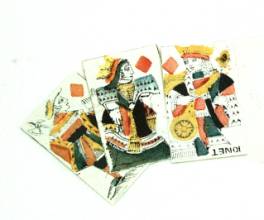Search
Website Design and Content © by Eric Krause,
Krause House Info-Research Solutions (© 1996)
All Images © Parks Canada Except
Where Noted Otherwise
Report/Rapport © Parks Canada / Parcs Canada
---
Report Assembly/Rapport de l'assemblée © Krause
House
Info-Research Solutions
Researching the
Fortress of Louisbourg National Historic Site of Canada
Recherche sur la Forteresse-de-Louisbourg Lieu historique national du Canada
Extracts of Matters of Historical Interest from "The Huissier, News For and About the Fortress of Louisbourg Heritage Presentation Staff" By The Fortress of Louisbourg Heritage Presentation Staff
THE HUISSIER
(July 13, 2005)

By
Ruby
Powell, Furnishings
It is believed that playing cards originated in China and made their way to Europe in the early fifteenth century.[1] Originally, cards were hand-painted and available only to the wealthy until they could be mass-produced via the printing process.
The
manufacturing of cards was one of the most heavily supervised industries because
of its popularity and the tax benefits from which the crown could draw.
Many rules and regulations were imposed to keep track of card producers
and their sales. France was broken
into regions and each card maker had a specific pattern to follow.
For example, cards fabricated in the Provence pattern were produced in
Avignon, Aix, Marseille, Toulon, Nimes and Montpellier.[2]
Each card maker was required to display their region and their name on
specific cards. Our original deck
features the Lionet family name on the King of Diamonds and the region of
Montpellier in the foot banner of the Jack of Clubs.
The most popular pattern in use in the 18th century was the Paris pattern and most likely would have been here at Louisbourg. Other French patterns, like our Provence pattern, as well as cards from New England probably arrived in Louisbourg depending on the origin of the owner.
The
reproduction cards are of the Provence pattern based on an original set of 52
cards in the Curatorial Collection. Most
patterns contained 52 cards with single end face cards and number cards from two
to ten in symbols of hearts, diamonds, spades and clubs.
Some decks contained 32 cards and used to play such games as Les Valets
whereas La Bataille could be played with 32 or 52 cards.
[3]
We
have placed some decks of cards in various locations about the site in the past
couple of days and more will follow. They
are smaller and more delicate than the English Williamsburg cards that are
currently in use in the houses so they will add a little variety.
Until
next time….
Ruby
[1] Wowk, Kathleen. Playing Cards of the World. A Collectors Guide. Hong Kong: Lutterworth Press, 1983, p83.
[2]
Marteau, Paul. Le Jeu De
Carte. Paris, France :
Hermann, éditeurs des sciences et des arts, p.140.
[3] O’Neill, Anne. Eighteenth Century French Playing Card Report. December, 21, 1978.